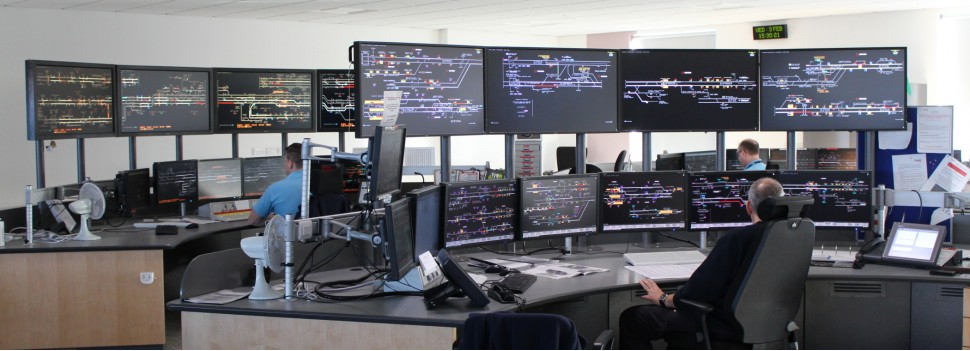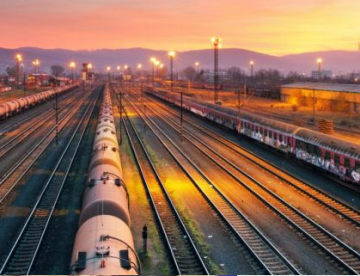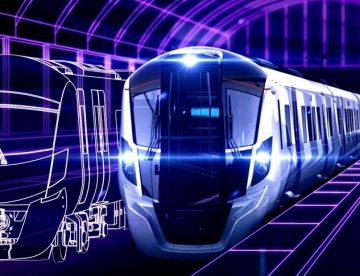Simulators dedicated to railway enterprises are mainly associated with simulators of driver’s cabs in 3D multi-monitor technology with mapping of vehicle behavior in motion. Changing regulations and the emphasis placed on railway traffic safety mean, however, that training also requires employees of other departments. Hitachi Information Control Systems Europe from the United Kingdom provides simulators that are used for training train dispatchers. I invite you to read the article below, which will allow you to familiarize yourself with these solutions that are not yet popular on the Polish market. This article discusses technical aspects and the use of similar technologies in training and regular verification of the skills of train dispatchers working in electronic traffic control centers. There are over 150 simulators in the UK, which are functional copies of traffic dispatcher workstations serving the relevant management areas
rail traffic. With precise modeling of the infrastructure operating within the SRK devices, accurate mapping of the screens and manipulators of control devices, according to the current timetable, with faithful reproduction of the topology and train motion characteristics.
P.S.
I am happy and proud to announce that the Polish-language Hitachi Information Control Systems Europe website has just been published. There you will also find much more interesting substantive materials and the latest news. I invite you to visit this page and contact us:
www.hitachi-infocon.com/pl
Introduction
High-quality simulations are a standard element of training programs for train dispatchers, enabling the exercise of routine tasks in the field of train movement and behavior in critical, emergency or in the event of any disturbances – in a safe, modeled,
and at the same time an extremely realistic environment. The train dispatcher or dispatcher participating in the training is under constant observation of an experienced trainer who has the ability to freely change scenarios: from standard undisturbed traffic situations to the most complex cases involving damage to trains, breakdowns, signaling, track sections, exceeding the “Stop” signals, adverse weather conditions etc.
Historical background
Traditional training of the train dispatcher was conducted in many countries on the basis of the joint work of an inexperienced student with the train dispatcher with many years of experience, and careful observation of the behavior and actions of an older colleague gave them the opportunity to imitate them. It was a training conducted during actual work, sometimes supplemented with demonstrations using miniature models of fragments of infrastructure, rolling stock or equipment. At the time of leverage benches
and simpler dashboards, these training methods were effective enough because both the geographical area and the workload were quite limited. Nevertheless, effectively practicing emergency scenarios and handling disturbances was significantly hindered because it was not possible to safely conduct them under real railway operating conditions. The trainings were limited to learning theories and conducted tests
based on textbooks, the next step was to gain experience in the daily practice of conducting real traffic. Therefore, an adept of art
(and even a train dispatcher with significant experience) could work for many months or even years without experiencing unusual or emergency situations. Many case studies from the railway sector and similar industries with increased safety requirements (aviation, nuclear power, etc.) have shown that learning principles and theories alone does not guarantee correct behavior in real emergency situations and only regular confrontation of personnel
with such events and their practical handling can ensure a high level of operational safety, predictability of behavior and effective normalization of the situation. For this reason, training based on learning the principles and theoretical lectures are now largely supplemented with classes based on methods of direct activity of participants and recognition of threats using realistic simulations.
Increase in the degree of automation
In the late 1980s, the first Signaling Control Center (SCC) was installed in the United Kingdom using the VDU (Visual Display Unit) system at Liverpool Street in London. The implementation of this technology has enabled a step change in both the complexity and geographical coverage of control areas. Along with VDU class solutions, automatic waveform tuning systems have appeared,
in which the fundamental tasks of arranging routes based on timetables, the emergence of simple disturbances and delays in traffic have increasingly begun to be automated. Therefore, the environment and work tools of the train dispatcher changed significantly. Lever benches, in which each element of movement was controlled directly, were replaced by automated devices servicing extended areas and unattended carrying out individual specific tasks. A higher degree of automation means that the duty officer more and more often and for quite long periods of time operates in an environment that generates too few tasks – but at the same time their number can suddenly increase to a level exceeding its capacity to realize or even perception in cases of breakdowns, large disruptions in traffic or other special circumstances. Therefore, basic and updated knowledge of the geographical control area should be maintained continuously to ensure the minimum delay of possible interventions. In the face of decreasing confrontation with atypical situations, simulations reflecting the way of real traffic management are the only method in which all hazards and events disrupting traffic can be visualized, analyzed and practiced – in a safe way that does not affect the operation of real infrastructure.
High quality simulators
In many industries, simulators are treated as solutions that faithfully reproduce the real operating environment so that their users are not able to figure out whether they work in real conditions or only simulated. The level of realism has been achieved in the aviation industry that training on simulators is used as the only method supplementing the competences of pilots transferred to operate other types of aircraft.
For railway signaling simulators, it is considered necessary that control centers based on VDU visualization systems meet the following requirements:
a) model of SRK devices used with response times identical to real devices. This ensures the same conditions for handling failures as in the case of a real control system – while maintaining signaling, display and interaction.
b) the displays and basic control devices used by the simulation participant (mouse, trackball and keyboard) are exact replicas of real devices. In practice, they are often the same peripherals.
c) the communication methods used by the traffic dispatcher are faithfully copied, e.g. two-way radios (Secure Car Audio) or telephones placed at the signal post (Signal Post Telephone).
d) the use of a real timetable for the simulated area and automatic mileage setting (if any).
e) use of all elements of the trail topology (inclination angles, speed limits, signal visibility) and rolling stock movement characteristics (acceleration / braking).
f) the standby traffic position is arranged as close as possible to the actual working conditions in the control center, e.g. furniture, lighting.
g) the possibility of any failures and disruptions in the infrastructure, such as track failures,
switches, signaling lamps, station devices (whole or modules) and trains, exceeding the signals ‘Stop’, freight train journeys not included in the timetable, etc.
h) recording and playback of simulation runs, the ability to analyze participants’ results.
Providing functionality with the markings from a) to f) guarantees that the simulator faithfully reproduces the work environment of the train dispatcher for training purposes
with the ability to conduct normal traffic including the timetable for any day and specific time.
The requirements specified in items g) to h) extend the possibilities of using the simulator far beyond standard operating operations. Thanks to them, it is possible to use the simulation to study and practice response to emergencies and any other irregularities. They are also a complete and auditable material documenting the course of the scenarios and actions taken.
The first high-quality simulators for control centers using visual systems were installed in the United Kingdom in the first years of the 21st century, immediately after the publication of key reports, which noted the lack of the possibility of safe training and regular assessment of train dispatchers outside the real conditions of their work. These early simulation solutions placed the trainee and trainer in the same room. It was soon realized that this was not an ideal solution – especially when there was a need for communication between the train dispatcher and a third party, e.g. a train driver. In connection with the trainer’s role as a train driver, it was found necessary to provide physical separation of the rooms occupied by them, mainly for the realism of voice communication. Due to the requirement of visual observation of the training participant and its impact on the correct assessment of his activities, glass walls were used, which are currently a standard solution. Acoustic separation of both rooms also excludes the risk of premature and unintentional transmission of signals to the training participant about the changes in the movement situation.
Failure and perturbations
In addition to simulating and practicing undisturbed railway traffic conditions, setting routes and issuing instructions, the creation of non-standard conditions is an important part of the simulation. Therefore, while the training participant receives images identical to the real readings occurring in the control center, the trainer uses a separate graphical interface presenting a more general picture of the geographical area
and a wide set of controls allowing the introduction of states deviating from normal motion situations. Usually, to start the simulation session, the trainer selects the timetable and the appropriate start time on a given day. The training participants’ screens are filled with images of trains set in appropriate positions for the selected take-off time and settings of SRK devices and signals along the route. During the session, the trainer introduces single or multi-element interference, which is immediately reflected in the material displayed on the participant’s screen, along with all relevant sound alarms. SRK devices and infrastructure elements also react in the same way as in real situations, ensuring that the trainee will have at his disposal exactly the same sequences of behavior of the control system,
with visual and sound operating conditions. If voice communication is required in response to the situation, the trainee or trainer may initiate an interconnection, whereby the trainer can assume the role of a third party. All voice messages are automatically recorded
with appropriate timestamps for later playback and review after the end of the training session. In addition to manually entering any amount of interference during the session, the trainer can also use previously prepared scripts containing appropriate simulation scenarios. This allows for automatic and maintenance-free triggering of a programmed amount of infrastructure failures and interruptions at the right time of the session, allowing the trainer to focus on observing the training participant’s behavior. This approach also allows comparative assessment of trainees based on the same scenarios.
Session recording
Each training session is recorded in a simulator for later analysis, playback and review with the trainee. It covers all elements of communication that occurred during it. A simple automatic report of the training participant’s results is available, but it is limited to analyzing compliance with the timetable, aggregating lost or saved minutes and the number of calls canceled. Further automation of the evaluation of training participants is considered by examining their actions in emergency situations, however, it is now considered that a much better method is to combine the participant’s observation and an expanded review of their behavior during the playback of saved simulations combined with the instructions given by the trainer.
Other uses
Although the fundamental purpose of using high-quality simulators was the training and examination of train dispatchers, the precision of the simulation opened up a number of other application possibilities. They include, inter alia, testing timetable changes before they are introduced, planning to increase the capacity of railway routes or travel restrictions during engineering works. Additional applications are also entering the sphere of human factor research in the face of completely new and significantly extended geographical areas managed through a single user interface. An example is the load effect of allowing a larger geographical area of infrastructure to be managed during periods of limited traffic in one position by one traffic dispatcher. Another application is to prepare the simulation at a very early stage of creating a new railway connection and signaling scheme. This allows the designed system to be tested in advance by the train dispatchers using the proposed timetable, higher traffic points and the analysis of all high-risk signals (such as passing the “Stop” signal) – before the projects are approved for implementation.
We invite you to deepen your knowledge about our simulators
HICSE Research & Development Team
Maciej Jędrzejczak
CEO of TransLink Master
maciej.jędrzejczak@translinkmaster.com
tel. +48 600 475 595




